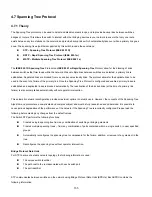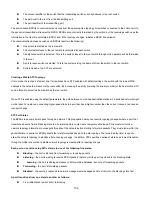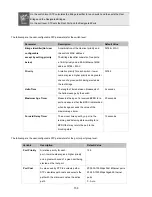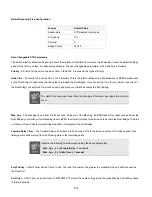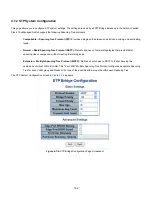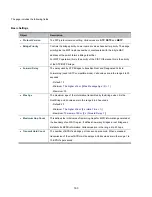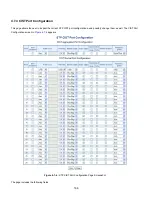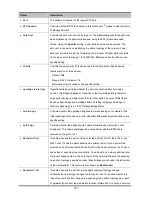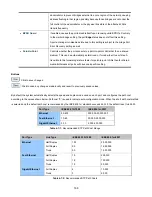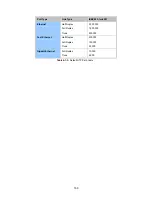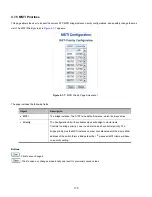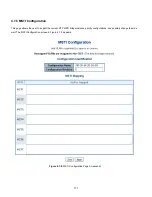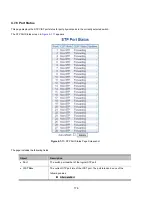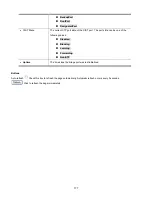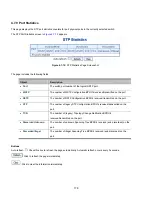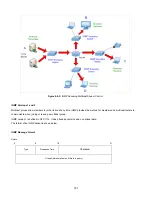
167
Object
Description
Port
The switch port number of the logical STP port.
STP Enabled
Controls whether RSTP is enabled on this switch port,
*
means to select all ports
of Managed Switch.
Path Cost
Controls the path cost incurred by the port. The
Auto
setting will set the path cost
as appropriate by the physical link speed, using the 802.1D recommended
values. Using the
Specific
setting, a user-defined value can be entered. The
path cost is used when establishing the active topology of the network. Lower
path cost ports are chosen as forwarding ports in favor of higher path cost ports.
Valid values are in the range 1 to 200000000.
All
means all ports will have one
specific setting.
Priority
Controls the port priority. This can be used to control priority of ports having
identical port cost. (See above).
Default:
128
Range: 0-240, in steps of 16
All
means all ports will have one specific setting.
operEdge (state flag)
Operational flag describing whether the port is connecting directly to edge
devices. (No Bridges attached). Transition to the forwarding state is faster for
edge ports (having
operEdge
true) than for other ports.The value of this flag is
based on AdminEdge and AutoEdge fields. This flag is displayed as Edge in
Monitor->Spanning Tree -> STP Detailed Bridge Status.
Admin Edge
Controls whether the operEdge flag should start as beeing set or cleared. (The
initial operEdge state when a port is initialized).
All
means all ports will have one
specific setting.
Auto Edge
Controls whether the bridge should enable automatic edge detection on the
bridge port. This allows operEdge to be derived from whether BPDU's are
received on the port or not.
Restricted Role
If enabled, causes the port not to be selected as Root Port for the CIST or any
MSTI, even if it has the best spanning tree priority vector. Such a port will be
selected as an Alternate Port after the Root Port has been selected. If set, it can
cause lack of spanning tree connectivity. It can be set by a network administrator
to prevent bridges external to a core region of the network influence the spanning
tree active topology, possibly because those bridges are not under the full control
of the administrator. This feature is also known as
Root Guard
.
Restricted TCN
If enabled, causes the port not to propagate received topology change
notifications and topology changes to other ports. If set it can cause temporary
loss of connectivity after changes in a spanning tree's active topology as a result
of persistently incorrect learned station location information. It is set by a network
Содержание NS4750-24S-4T-4X
Страница 1: ...NS4750 24S 4T 4X User Manual P N 1702826 REV 00 01 ISS 14JUL14 ...
Страница 56: ...56 Figure 4 2 7 Privilege Levels Configuration Page Screenshot ...
Страница 110: ...110 Figure 4 4 6 Mirror Configuration Page Screenshot ...
Страница 117: ...117 Figure 4 5 4 LACP Port Configuration Page Screenshot ...
Страница 136: ...136 Figure 4 6 5 VLAN Port Status for Static User Page Screenshot The Page includes the following fields ...
Страница 144: ...144 Figure 4 6 10 Change Port VLAN of Port 1 3 to be VLAN2 and Port VLAN of Port 4 6 to be VLAN3 ...
Страница 174: ...174 Figure 4 7 10 MST1 MSTI Port Configuration Page Screenshot ...
Страница 180: ...180 Figure 4 8 2 Multicast Flooding ...
Страница 249: ...249 Figure 4 9 18 Voice VLAN Configuration Page Screenshot ...
Страница 271: ...271 Counter Counts the number of frames that match this ACE ...
Страница 281: ...281 Figure 4 11 4 Network Access Server Configuration Page Screenshot ...
Страница 315: ...315 ...
Страница 328: ...328 ...
Страница 335: ...335 ...
Страница 346: ...346 Figure 4 14 1 LLDP Configuration Page Screenshot ...
Страница 350: ...350 Figure 4 14 2 LLDP MED Configuration Page Screenshot ...
Страница 372: ...372 Figure 4 16 1 Loop Protection Configuration Page Screenshot ...
Страница 377: ...377 Falling Threshold Falling threshold value 2147483648 2147483647 Falling Index Falling event index 1 65535 ...



